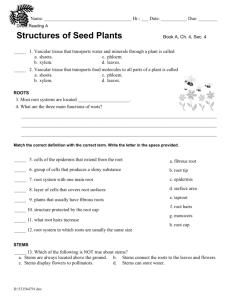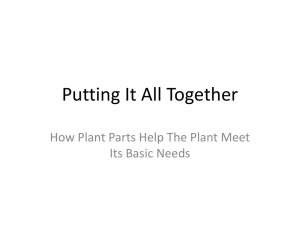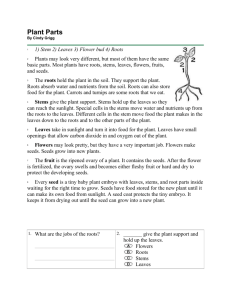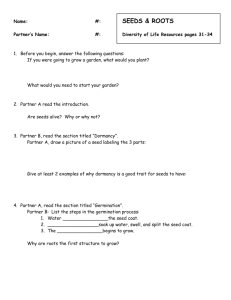biology-notes-chapters-27-31
advertisement
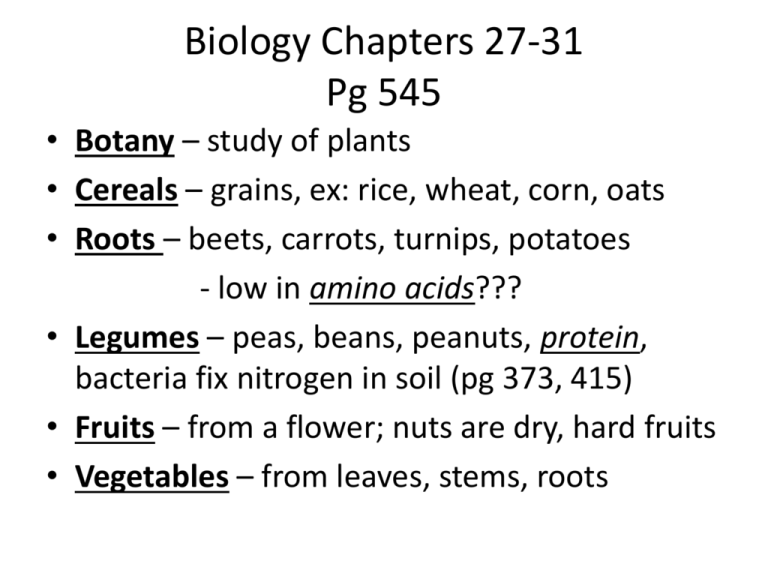
Biology Chapters 27-31 Pg 545 • Botany – study of plants • Cereals – grains, ex: rice, wheat, corn, oats • Roots – beets, carrots, turnips, potatoes - low in amino acids??? • Legumes – peas, beans, peanuts, protein, bacteria fix nitrogen in soil (pg 373, 415) • Fruits – from a flower; nuts are dry, hard fruits • Vegetables – from leaves, stems, roots Quiz Your Brain • Do you think plants are the same now as they were 100’s of years ago? • As the human population continues to grow what do you think will happen to our food sources? • What processes do you think helps farmers with mass production of our fresh fruits? • Fertilizers – extra nutrients for plants, chemical or natural (organic, manure, compost) • Pesticides – kills bugs on plants, chemical or natural (hot spices) • Herbicides – weed killer, chemical or natural (ground cover: plant that grows over an area of ground, used to provide protection from erosion and drought as well as helping to prevent unwanted vegetation. Nonfood Uses Pg. 548-550 • Medicine: Bark of a White Willow used to make Acetylsalicylic Acid (Aspirin) • Clothing: Tanning animal hides to make leather. Tannin from Oak trees. Addictive Plants Pg. 556 • Coca Plant • Tobacco Quiz Your Brain • List three ways that some plants can cause harm to people. • List three nonfood, nonmedicinal uses of plants. Types of Plants Chapter 28 Pg 564 • NONVASCULAR Phylum Bryophytes – mosses 1. nonvascular plants 2. no tubes for water or food 3. absorbs water from ground 4. lives in damp, low areas 5. pioneer species 6. creates soil 7. no true roots, stems, leaves • VASCULAR – tubes (xylem for water, phloem for sugar) 1. With spores instead of seeds – ex: ferns Pg 580 2. With seeds A. Gymnosperms – cones male & female Pg 611 & 581 B. Angiosperms – flowers 1. monocot 2. dicot handouts, Pg 576, 613, 594 Angiosperm or Gymnosperm Quiz Your Brain • Plants can be classified into 2 categories which are…. • Plants that produce cones are classified as…… • Plants that produce flowers are classified as… • What special tissue helps transport water and nutrients to all the parts of the plant? Flower Power Activity • • • • • • • • Color corresponding flower parts: Purple – Petals (# 1, 2, and 3) Yellow – Stamens (# 4 and 5) Orange – Anthers (# 6 and 7) Red – Ovules (# 8, 9, and 10) Lavender – Stigma/Style (#11) Pink – Ovary (#12) Green – Sepal/Peduncle (#13) Chapter 29 Pg 583 Plant Tissues • Leaf layers – handout, Pg 601 • Types of roots Pg 587 1. Taproot – one main root, dicots, dandelions 2. Fibrous roots – many little roots, monocots, grass Stem growth Pg 586 • Apical Meristems – grow from top of stem or root Pg 588, grass grows after mowing, primary growth, monocots • Lateral Meristems – grow in diameter, secondary, dicots 1. Vascular Cambium – makes more tubes 2. Cork Cambium – replaces epidermis w/ dead cork, can’t change size, ruptures as tree grows & makes bark look rough • Heartwood – old xylem in center of tree that doesn’t transport water anymore, dark • Sapwood – functional xylem wood, light • Annual Rings – thick springwood, lots of water - thin summerwood due to less water - Pg 595 Quiz Your Brain • Heartwood and Sapwood are an example of what kind of growth? • Are all tree rings the same width? • What is a Dendrochronolgy? Stem Functions Pg 596 • Translocation – moving sugar using pressure • Transpiration – moving water using: cohesion – water attracted to water adhesion – water attracted to xylem wall capillarity – thinness of xylem draws water up like a straw Quiz Your Brain • Explain why a plant species might develop thorny stems in response to its environment. • Describe how water is transported through xylem tissue. Pollination & Seed Dispersal/Structure Chapter 30 Pg 616-20 • Wind – flat flowers, lots of pollen/seeds • Animals – colorful, smelly flowers, tasty fruit, sticky seeds/fruit/burs • Water – seeds or fruits able to float • Seed Coat – protection • Endosperm – nutrients in seed to help germination (sprouting) Quiz Your Brain • How do the flowers of wind-pollinated plants differ from the flowers of animal-pollinated plants? • Lack scents, nectar, and large colorful flowers. Animal-pollinated plants usually have these. • Name three common methods of fruit and seed dispersal. • Wind, Water, Animals Chapter 31 Pg 632 Plant Hormones • Chemical Messengers that affect a plants ability to respond to its environment. • Auxins – growth • Gibberellins–big fruit, grapes Pg 634 • Ethylene – ripening fruit (keep fruit in bag to ripen faster) Plant Movement Pg 636 • Photropism – plant in window moves toward sun • http://plantsinmotion.bio.indiana.edu/plantmoti on/movements/tropism/tropisms.html • Heliotropism – sunflowers follow sun all day • Thigmotropism – vines hold on to what it contacts • Gravitropism – roots grow towards gravity, stems grow away from gravity • Thigmonastic – leaves close on contact • http://www.youtube.com/watch?v=pgNTRaxgVtg Seasonal Responses Pg 640 • Photoperiodism – plants that respond to length of day short day plants – need more darkness ex: poinsettia, ragweed (fall allergies), mums, fall flowers long day plants – need more light ex: wheat, summer flowers Quiz Your Brain • What adaptive advantages might thigmonastic movements provide a plant? • Which hormone is could be called the “ripening hormone”, and why? Fall Colors Pg 642 • Less chlorophyll when less sun. • Carotenoids visible: (always there but hidden) 1. xanthophylls – yellow/orange 2. anthocyanins - reds
